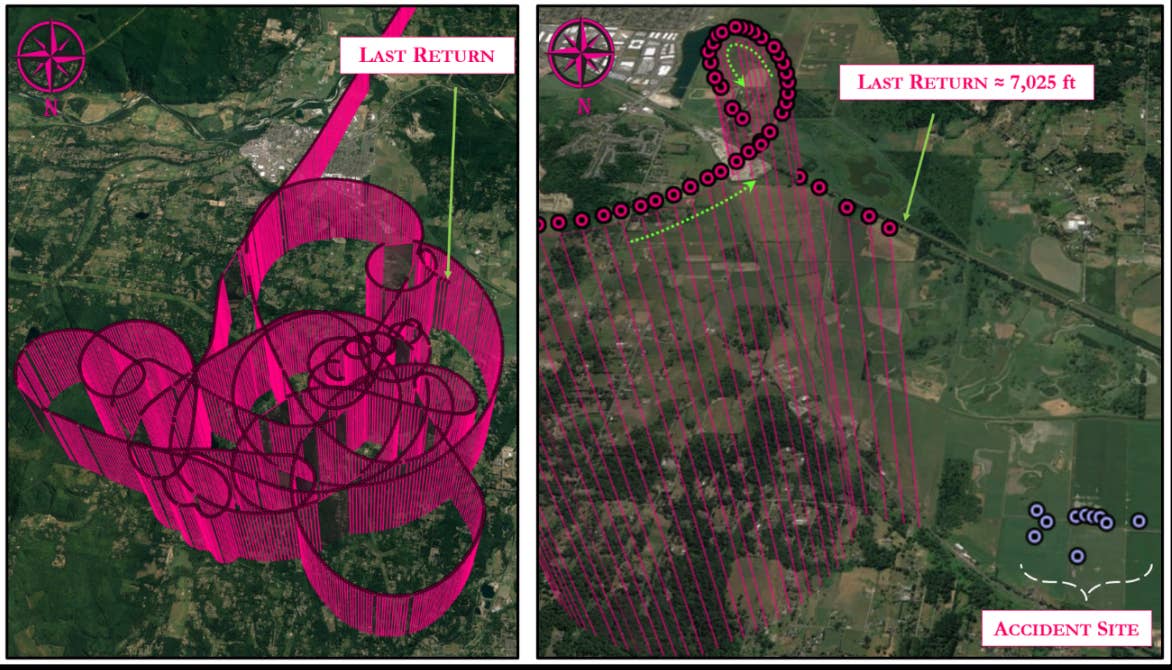Lawsuit Filed Over Fatal Caravan Flight in Washington
Allegations of catastrophic wing failure are brought forth.

The NTSB collected radar data of the aircraft maneuvering during flight (left) and its last turns. [Courtesy: NTSB]
“Wings should not come off in flight” are the words that begin the argument for a lawsuit filed by Danielle Martin, the widow of Nathan Precup, one of four men killed during the test flight of a modified Cessna 208B EX Caravan over Snohomish, Washington, north of Seattle, in November 2022.
The wrongful death suit was filed by law firms Stritmatter Kessler Koehler Moore and Wisner Baum on behalf of Precup. King County, Washington, names Textron Aviation Inc., Mistequay Group Ltd. (Aeromotion by Textron Aviation), Ace Aviation Inc., Raisbeck Engineering Inc., and "John Doe one through ten" as defendants. These are the businesses that designed, manufactured, and maintained the Cessna Caravan.
As previously reported by FLYING and according to the preliminary report from the National Transportation Safety Board (NTSB), the right wing separated from the aircraft during flight.
About the Mission
The purpose of the flight was to test Raisbeck Engineering's aerodynamic reduction system. Precup, 33, was working for Raisbeck as the instrumentation engineer during the test flights. The Raisbeck company makes modifications for corporate and business aircraft to improve performance and efficiency. The Caravan was on loan to Raisbeck Engineering. According to the complaint, the aircraft was owned by Copper Mountain Aviation LLC.
According to the NTSB, Raisbeck holds the supplemental type certificate (STC) for an aerodynamic drag reduction system (DRS) on the Cessna 208B. The purpose of the flight was to test the ability to expand the applicability of that DRS to the Cessna 208B EX model.
Raisbeck noted the flight was conducted prior to the installation of a Raisbeck modification, which is “standard industry practice that allows aviation engineering firms to establish baseline aircraft performance under a highly structured flight profile to later measure and compare the change in performance after any proposed modifications are installed. The aircraft was in this initial testing phase and had not yet been modified in any way.”
The accident happened during the last of a five-flight series to establish baseline performance. In addition to Precup, both pilots and the test director were killed. Several flights with several test pilots were completed in the days leading up to the accident.
The first flight took place on November 15 and consisted of three segments totaling 1.1 hours. The purpose of the flight was for the pilots to build familiarity with the aircraft and a ferry flight to have the airplane’s weight and balance performed. The next day the aircraft was flown for a total of 4.6 hours to establish baseline data for future test flights for both mid-center-of-gravity (CG) cruise flight and forward CG stall speeds. On November 17 two more test flights were completed, for a total of 1.2 hours to test the aft CG static stability. The last flight on the 17th was cut short with only half of the planned test maneuvers completed because a crewmember in the back of the airplane was feeling ill.
The final flight took place the morning of November 18. The intention of the flight was to complete the test maneuvers from the prior day, which consisted of testing the aircraft’s stall performance.
The aircraft's radar track shows it taking off from Renton Municipal Airport (KRNT) around 9:25 a.m. PST and heading north. The conditions were VFR as the airplane climbed to about 9,500 feet msl and began a series of turns. The airplane flew for approximately 45 minutes, its altitude varying between about 6,500 feet to 10,275 feet.
At 10:17 a.m., the track data showed the airplane in a climbing left turn. It was just about to complete a 360-degree turn when it abruptly entered a sharp 180-degree left turn to the west. The last 12 seconds of the radar capture show the airplane in a descent exceeding 14,000 fpm and gradually lessened to 8,700 fpm at the last report. The main wreckage was located about 2,145 feet east of the last recorded track data. The right wing was located some distance away.
The pilot who had flown the test flights the day before told investigators that it appeared that the flight crew were conducting the second-to-last maneuver on the card, which specified: 96 knots indicated airspeed; flaps in landing configuration; 930 foot-pounds of torque; propeller rpm fully forward; and accelerated 30-degree bank to the left.
Witnesses on the ground reported seeing the airplane "fall apart" in midair then corkscrew to the ground. The event was captured by a security camera, and several witnesses reported seeing a white plume of smoke when they observed the airplane break into pieces. The fuselage appeared to be rotating about its longitudinal axis in a nose-low attitude.
Investigators noted that the right wing was found 200 yards from the main wreckage. The main wreckage, consisting of the engine, cockpit (and cargo pod), cabin, vertical stabilizer, and rudder, was partially consumed by fire. The right-wing strut had separated from the fuselage attachment point but remained attached to the wing. The right flap was separated into numerous pieces and scattered among the debris field. The left wing separated from the fuselage, although it was located adjacent to the main wreckage. The flap remained attached and was found in the retracted position.
The NTSB is still investigating the cause of the accident.

Subscribe to Our Newsletter
Get the latest FLYING stories delivered directly to your inbox






